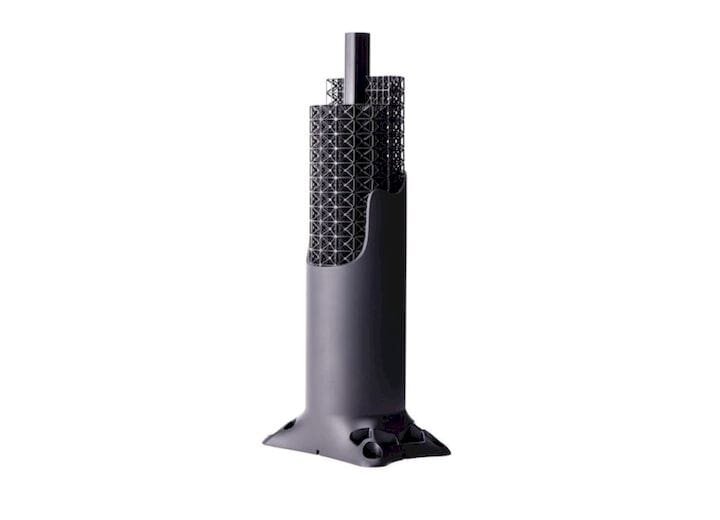 A 3D-printed part made with rigid polyurethane and internal lattice structures. (Image courtesy of Protolabs.)
A 3D-printed part made with rigid polyurethane and internal lattice structures. (Image courtesy of Protolabs.)
Minnesota-based Protolabs announced this week the addition of Carbon’s Digital Light Synthesis (DLS) technology to its portfolio of manufacturing and prototyping technologies.
Using DLS, the company will be able to tackle new types of orders and customers. To learn more, we spoke to Greg Thompson, Protolabs’ global product manager for 3D printing.
Unlike standard additive manufacturing (AM) service providers, Protolabs is not focused entirely on 3D printing. In reality, AM is one of three other services that include injection molding, sheet metal fabrication and CNC machining. Altogether, these are meant to service any given client, depending on their needs. This means that the proper manufacturing process can be used when necessary, rather than trying to rework a part to make it fit with a certain technology.
That said, Protolabs is among the largest suppliers of custom 3D printing services, fabricating over 100,000 3D-printed parts per month, using six different AM technologies: direct metal laser sintering, stereolithography, Multi Jet Fusion (MJF) from HP, selective laser sintering (SLS), PolyJet and, now, DLS from Carbon.
“We really pride ourselves on being the world’s fastest, on-demand, digitally enabled manufacturing partner with four primary services,” Thompson said. “We continually expand our product offerings over to meet needs and solve problems for our customers. One of the things we’re really committed to having is a prototyping and on-demand production solution for our customers in each of our services. In large part that’s the role that we hope Carbon can play with our AM lineup.”
Thompson explained that Protolabs’s AM systems perform both prototyping and production jobs. In terms of production, the firm’s GE Concept Laser technology, as well as its MJF and SLS machines is often the go-to machines for metal and plastics, respectively. He believes that DLS might offer a great balance of cost and material properties for plastic 3D printing.
“If you think about traditional 3D printing technologies, they tend to be limited either by cost or material properties. Those that had the right properties weren’t always the strongest materials or were pretty expensive in the case of metals. In terms of plastics, those that had the better mechanical properties had issues with surface finish or feature size,” Thompson said. “Carbon’s DLS tech—especially with the performance materials, which include the rigid polyurethane and the flexible polyurethane that we’re offering—they’re able to set themselves apart.”
The strength of DLS comes from a combination of the actual 3D printing process itself and Carbon’s materials, like those mentioned by Thompson. DLS improves upon digital light projection 3D printing through the use of an oxygen permeable membrane that allows for much quicker printing times and isotropic parts. Carbon describes these parts as layerless, in that each layer of hardened resin is seamlessly bound to the previous and subsequent layers. There are, therefore, no layer lines and no Z-axis weakness, as seen with the majority of other 3D printing technologies.
Additionally, the material chemistries themselves have been developed in such a way that, upon post-print curing, specific engineering properties can be “unlocked.” Once prints are cured, the components become stronger, for instance.
“[Carbon] can offer more advanced material properties that are fairly isotropic with good surface quality and really fast build speeds,” Thompson said. “That makes the Carbon parts closer to injection molding that engineers are used to working with, which makes Carbon more viable for applications that we couldn’t really previously support.”
With the release of Carbon’s L1 and M2 3D printers, along with the Smart Part Washer system, Carbon aimed to address the needs of manufacturers. These larger machines are meant to be used for larger parts or larger batches of parts, making it possible to do serial production. Therefore, we’ve seen DLS used more and more for the manufacturing of end parts and not just prototypes. This includes bicycle seats for Specialized and fizik, as well as shoes for Adidas.
Read more at ENGINEERING.com

